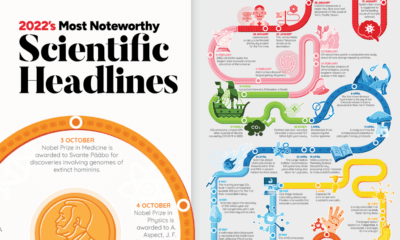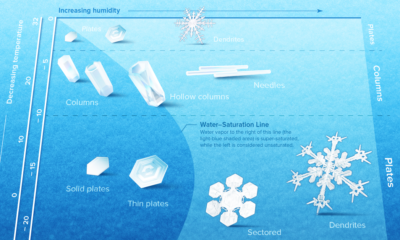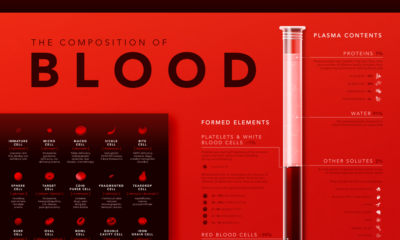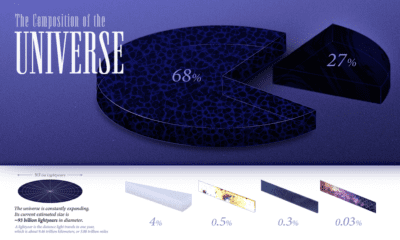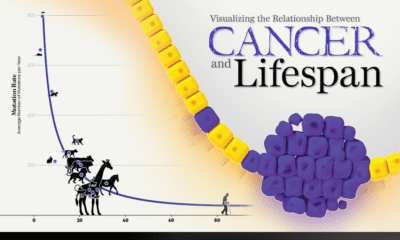They can take many forms, from the venom of a snake or spider to the neurotoxins produced by certain types of algae or microbes. In the infographic above, we look at some common biotoxins in the natural world and rank them based on how deadly they are to an average 70 kg (154 lb) human being.
Ranking Biotoxins on a Toxic Scale
A basic concept in toxicology is that “only the dose makes the poison”. Everyday harmless substances like water have the potential to be lethal when consumed in large enough concentrations. Measuring a lethal dosage is very difficult. First, living things are complex: factors like size, diet, biochemistry, and genetics vary across species. This makes it difficult to qualify toxicity in a universal way. Second, individual factors like age or sex can also affect how deadly a substance is. This is why children have different doses for medications than adults. Third, how a poison is taken into the body (orally, intravenously, dermally, etc.) can also impact its deadliness. As a result, there are many ways to measure and rank toxicity, depending on what substance or organism is under investigation. Median lethal dose (LD50) is one common way for measuring toxicity. LD50 is the dose of a substance that kills 50% of a test population of animals. It is commonly reported as mass of substance per unit of body weight (mg/kg or g/kg). In the graphic above, we curate LD50 data of some select biotoxins found in nature and present them on a scale of logarithmic LD50 values. What’s surprising is just how potent some toxins can be.
Bits and Bites about Biotoxins
While one would think that biotoxins are avoided at all costs by humans, the reality is more complicated. Here are some interesting facts about biotoxins present in nature, and our unusual relationships with the organisms that create them:
- Fungi and molds make poisons called mycotoxins Mycotoxins are a global problem. They affect crops from many countries, and can cause significant economic losses for farmers and food producers.
- Phytotoxins can defend plants…and attack cancer Plants use phytotoxins to defend themselves other organisms, like humans. Urushiol, for example, is the main toxic component in the leaves of poison ivy, poison oak, and sumac. But the Pacific yew tree produces taxol that’s valuable in chemotherapy treatments.
- Fire salamander toxin is an ingredient in Slovenian whisky Though not widely available, some whisky makers in Slovenia use samandarine from the fire salamander to create a psychedelic alcohol.
- Ciguatoxins exist in the guts of reef fish Very unique species of bacteria living in the digestive tract of reef fishes make ciguatoxin. They transmit this poison to other organisms when the host fish is eaten.
- Pufferfish are deadly, but also delicious Pufferfish contain tetrodotoxin, a potent neurotoxin in their ovaries, liver, and skin called tetrodotoxin. Despite being a delicacy in many countries around the world, it has a lot of strict regulations because of its ability to kill people. In Japan, for example, only specially licensed chefs can prepare pufferfish for consumption.
- Batrachotoxin is lethal to the touch The skin of some poison dart frogs secretes a deadly substance called batrachotoxin. It is so potent that simply touching the poison can be fatal. Indigenous people of Central and South America used batrachotoxin to poison the tips of hunting weapons for centuries.
- Botox contains the most deadly biotoxin known Commercial botox uses an extremely small amount of biotoxin from a microbe called Clostridium botulinum. It paralyzes the muscles, preventing contraction (i.e. wrinkling). It is the deadliest known biotoxin on Earth. One gram of botulinum toxin can kill up to one million people.
Caveats of Measuring and Reporting Biotoxicity
While we use LD50 data to rank biotoxicity, it isn’t an exact science. There is room for improvement. For starters, no LD50 data exists for humans. That means data from other organisms has to be converted to apply to humans. There is a lot of contention amongst scientific communities about how accurate this is. There has also been an increasing effort to move to new methods of measuring toxicity that are not harmful to animals. Several countries, including the UK, have taken steps to ban the oral LD50, and the Organisation for Economic Co-operation and Development (OECD) abolished the requirement for the oral test in 2001. Now, new ways of evaluating toxicity are under investigation, like cell-based screening methods. Correction: Water was mislabeled on a previous version of the infographic. Full sources here on Even while political regimes across these countries have changed over time, they’ve largely followed a few different types of governance. Today, every country can ultimately be classified into just nine broad forms of government systems. This map by Truman Du uses information from Wikipedia to map the government systems that rule the world today.
Countries By Type of Government
It’s important to note that this map charts government systems according to each country’s legal framework. Many countries have constitutions stating their de jure or legally recognized system of government, but their de facto or realized form of governance may be quite different. Here is a list of the stated government system of UN member states and observers as of January 2023: Let’s take a closer look at some of these systems.
Monarchies
Brought back into the spotlight after the death of Queen Elizabeth II of England in September 2022, this form of government has a single ruler. They carry titles from king and queen to sultan or emperor, and their government systems can be further divided into three modern types: constitutional, semi-constitutional, and absolute. A constitutional monarchy sees the monarch act as head of state within the parameters of a constitution, giving them little to no real power. For example, King Charles III is the head of 15 Commonwealth nations including Canada and Australia. However, each has their own head of government. On the other hand, a semi-constitutional monarchy lets the monarch or ruling royal family retain substantial political powers, as is the case in Jordan and Morocco. However, their monarchs still rule the country according to a democratic constitution and in concert with other institutions. Finally, an absolute monarchy is most like the monarchies of old, where the ruler has full power over governance, with modern examples including Saudi Arabia and Vatican City.
Republics
Unlike monarchies, the people hold the power in a republic government system, directly electing representatives to form government. Again, there are multiple types of modern republic governments: presidential, semi-presidential, and parliamentary. The presidential republic could be considered a direct progression from monarchies. This system has a strong and independent chief executive with extensive powers when it comes to domestic affairs and foreign policy. An example of this is the United States, where the President is both the head of state and the head of government. In a semi-presidential republic, the president is the head of state and has some executive powers that are independent of the legislature. However, the prime minister (or chancellor or equivalent title) is the head of government, responsible to the legislature along with the cabinet. Russia is a classic example of this type of government. The last type of republic system is parliamentary. In this system, the president is a figurehead, while the head of government holds real power and is validated by and accountable to the parliament. This type of system can be seen in Germany, Italy, and India and is akin to constitutional monarchies. It’s also important to point out that some parliamentary republic systems operate slightly differently. For example in South Africa, the president is both the head of state and government, but is elected directly by the legislature. This leaves them (and their ministries) potentially subject to parliamentary confidence.
One-Party State
Many of the systems above involve multiple political parties vying to rule and govern their respective countries. In a one-party state, also called a single-party state or single-party system, only one political party has the right to form government. All other political parties are either outlawed or only allowed limited participation in elections. In this system, a country’s head of state and head of government can be executive or ceremonial but political power is constitutionally linked to a single political movement. China is the most well-known example of this government system, with the General Secretary of the Communist Party of China ruling as the de facto leader since 1989.
Provisional
The final form of government is a provisional government formed as an interim or transitional government. In this system, an emergency governmental body is created to manage political transitions after the collapse of a government, or when a new state is formed. Often these evolve into fully constitutionalized systems, but sometimes they hold power for longer than expected. Some examples of countries that are considered provisional include Libya, Burkina Faso, and Chad.


